Abstract
A genetical model is found to provide a good fit to family data on vitiligo. The model postulates that recessive alleles at a set of four unlinked diallelic loci are involved in the causation of the disorder. Under this multiple recessive homozygosis model, for normal X affected families ascertained through the affected parent, the expected segregation probability is .063; the estimated value is 0.53, which is not significantly different from the expected value. For normal X normal families ascertained through an affected offspring, the expected segregation probability is .037; the estimated value is .04.
Full text
PDF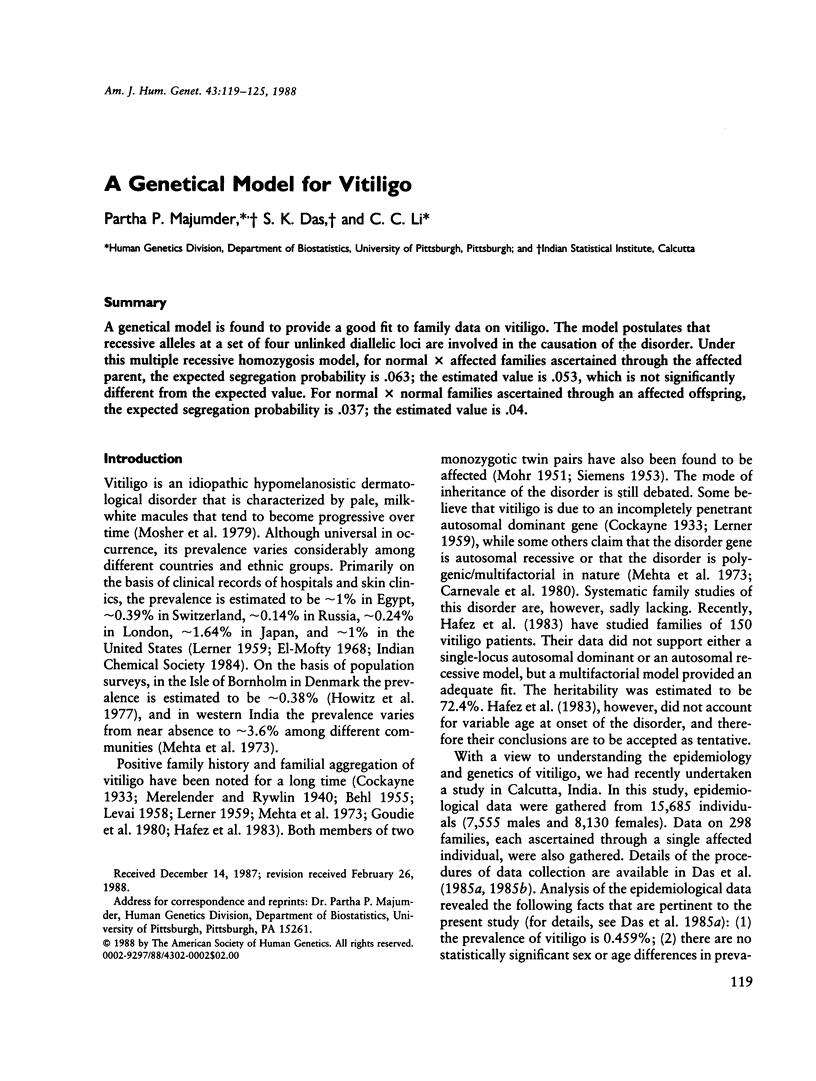
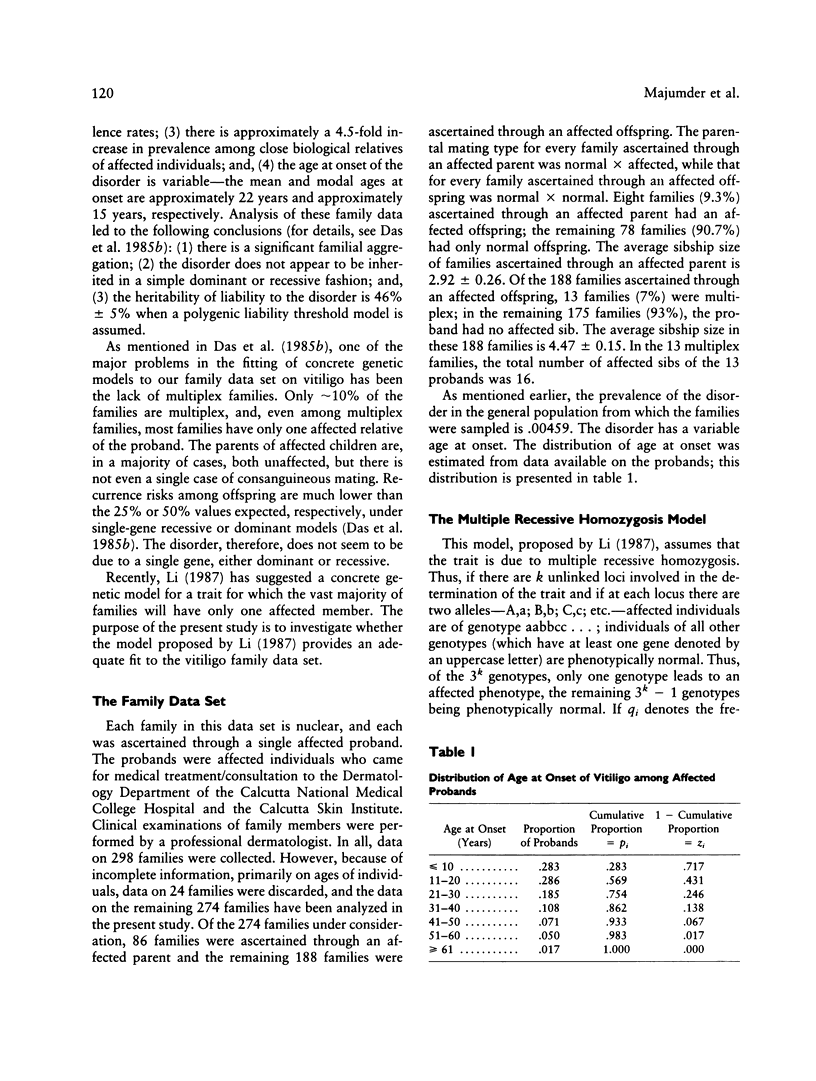
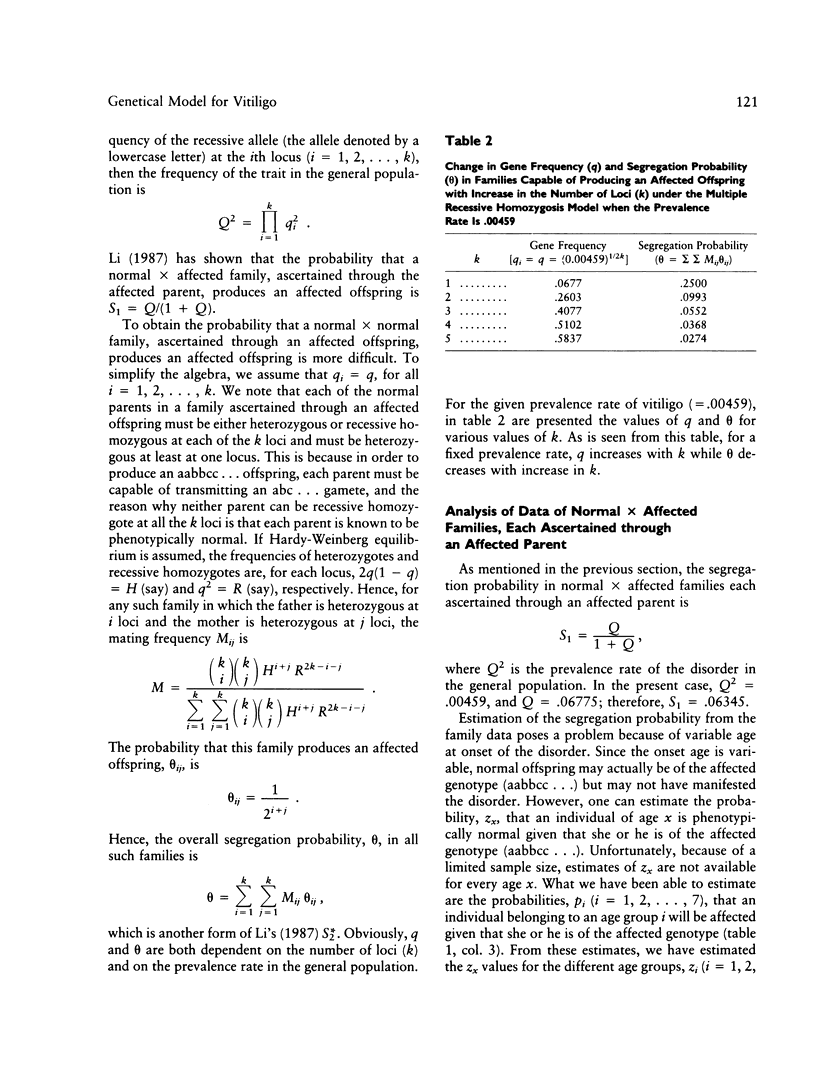
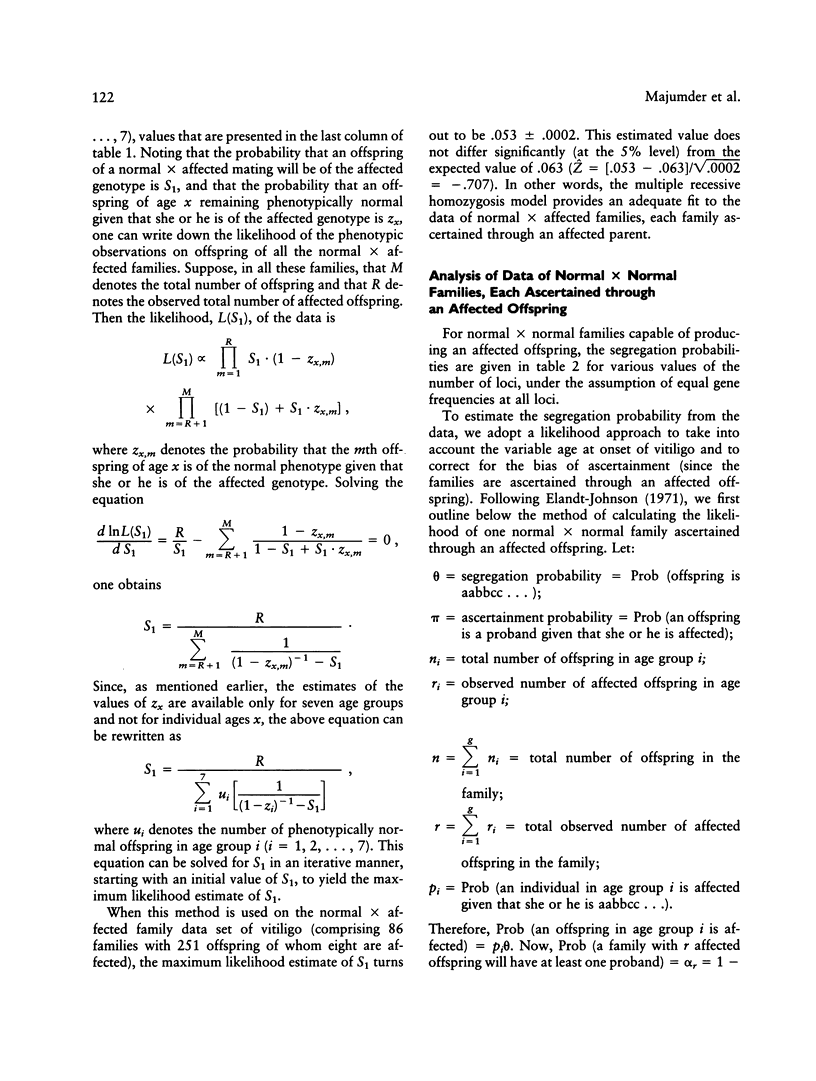

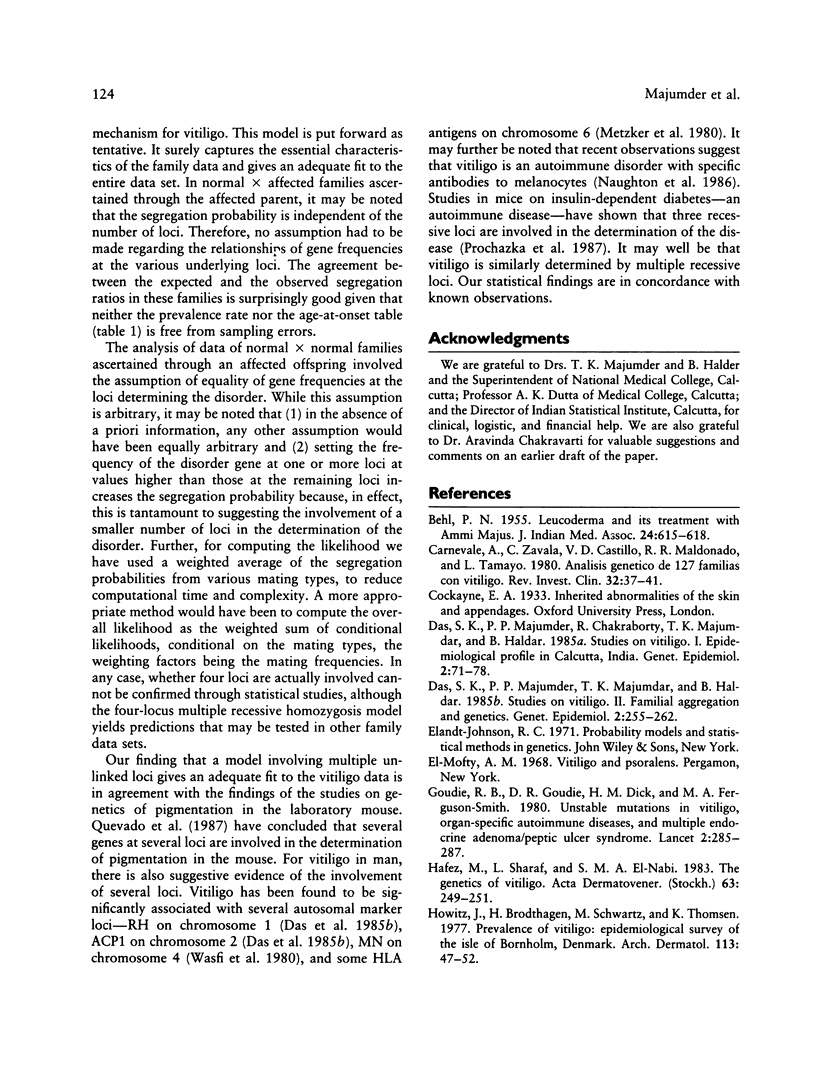
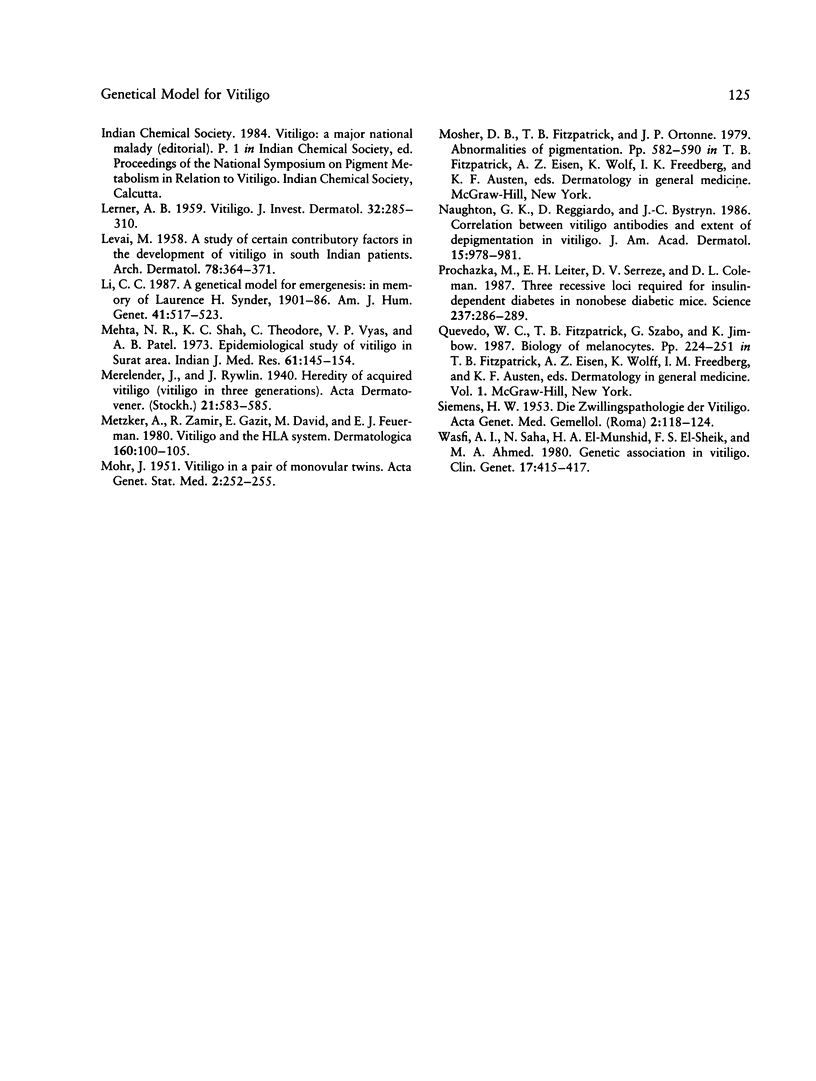
Selected References
These references are in PubMed. This may not be the complete list of references from this article.
- BEHL P. N. Leucoderma and its treatment with Ammi majus. J Indian Med Assoc. 1955 May 16;24(16):615–618. [PubMed] [Google Scholar]
- Carnevale A., Zavala C., del Castillo V., Ruíz Maldonado R., Tamayo L. Análisis genético de 127 familias con vitiligo. Rev Invest Clin. 1980 Jan-Mar;32(1):37–41. [PubMed] [Google Scholar]
- Das S. K., Majumder P. P., Chakraborty R., Majumdar T. K., Haldar B. Studies on vitiligo. I. Epidemiological profile in Calcutta, India. Genet Epidemiol. 1985;2(1):71–78. doi: 10.1002/gepi.1370020107. [DOI] [PubMed] [Google Scholar]
- Das S. K., Majumder P. P., Majumdar T. K., Haldar B. Studies on vitiligo. II. Familial aggregation and genetics. Genet Epidemiol. 1985;2(3):255–262. doi: 10.1002/gepi.1370020303. [DOI] [PubMed] [Google Scholar]
- Goudie R. B., Goudie D. R., Dick H. M., Ferguson-Smith M. A. Unstable mutations in vitiligo, organ-specific autoimmune diseases, and multiple endocrine adenoma/peptic-ulcer syndrome. Lancet. 1980 Aug 9;2(8189):285–287. doi: 10.1016/s0140-6736(80)90235-4. [DOI] [PubMed] [Google Scholar]
- Hafez M., Sharaf L., Abd el-Nabi S. M. The genetics of vitiligo. Acta Derm Venereol. 1983;63(3):249–251. [PubMed] [Google Scholar]
- Howitz J., Brodthagen H., Schwartz M., Thomsen K. Prevalence of vitiligo. Epidemiological survey on the Isle of Bornholm, Denmark. Arch Dermatol. 1977 Jan;113(1):47–52. doi: 10.1001/archderm.113.1.47. [DOI] [PubMed] [Google Scholar]
- LERNER A. B. Vitiligo. J Invest Dermatol. 1959 Feb;32(2 Pt 2):285–310. [PubMed] [Google Scholar]
- LEVAI M. A study of certain contributory factors in the development of vitiligo in South Indian patients. AMA Arch Derm. 1958 Sep;78(3):364–371. doi: 10.1001/archderm.1958.01560090080017. [DOI] [PubMed] [Google Scholar]
- MOHR J. Vitiligo in a pair of monovular twins. Acta Genet Stat Med. 1951;2(3):252–255. doi: 10.1159/000150674. [DOI] [PubMed] [Google Scholar]
- Mehta N. R., Shah K. C., Theodore C., Vyas V. P., Patel A. B. Epidemiological study of vitiligo in Surat area, South Gujarat. Indian J Med Res. 1973 Jan;61(1):145–154. [PubMed] [Google Scholar]
- Metzker A., Zamir R., Gazit E., David M., Feuerman E. J. Vitiligo and the HLA system. Dermatologica. 1980;160(2):100–105. doi: 10.1159/000250480. [DOI] [PubMed] [Google Scholar]
- Naughton G. K., Reggiardo D., Bystryn J. C. Correlation between vitiligo antibodies and extent of depigmentation in vitiligo. J Am Acad Dermatol. 1986 Nov;15(5 Pt 1):978–981. doi: 10.1016/s0190-9622(86)70260-0. [DOI] [PubMed] [Google Scholar]
- Prochazka M., Leiter E. H., Serreze D. V., Coleman D. L. Three recessive loci required for insulin-dependent diabetes in nonobese diabetic mice. Science. 1987 Jul 17;237(4812):286–289. doi: 10.1126/science.2885918. [DOI] [PubMed] [Google Scholar]
- SIEMENS H. W. Die Zwillingspathologie der Vìtiligo. Acta Genet Med Gemellol (Roma) 1953 May;2(2):118–125. [PubMed] [Google Scholar]
- Wasfi A. I., Saha N., El Munshid H. A., El Sheikh F. S., Ahmed M. A. Genetic association in vitiligo: ABO, MNSs, Rhesus, Kell and Duffy blood groups. Clin Genet. 1980 Jun;17(6):415–417. doi: 10.1111/j.1399-0004.1980.tb00172.x. [DOI] [PubMed] [Google Scholar]


